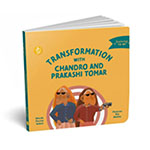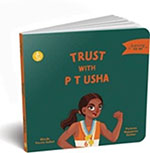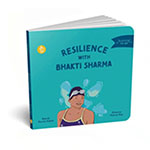

Yet, sports is an arena ridden with gender inequality. As per recent research by BBC, statistics show that approximately 75% of the Indian population believe that sports is significant in their day-to-day lives; however, only 36% of them engage in any sort of sport or physical activity. Of these only 29% of women engage in sports.
It is in this kind of a paradoxical background that we look at the set of four books from AdiDev Press narrating stories of Indian women in sports—written in short, playful verse by Pervin Saket and illustrated by different artists. The verses and the pictures narrate the stories of five pioneering Indian women: Bhakti Sharma, Arunima Sinha, PT Usha and Chandro and Prakashi Tomar building on some larger values that these sportswomen can be identified with. They made a mark in the spheres of Athletics, mountaineering, swimming and shooting. The books are a part of a larger series called ‘Learning to be’, where other similar sets of biographies of women scientists and spiritual leaders have been published. AdiDev Press claims to ‘introduce children to South Asian culture, history and traditions’ through their books.
ResiliencewithBhaktiSharma—a story that dwells on the life experiences of the first Asian woman and the youngest in the world to set a record in open swimming in Antarctic waters. Sharma, born in Mumbai and growing up in Udaipur, Rajasthan, started swimming at a young age of two and a half years, coached by her mother Leena Sharma. After having participated in many State and District Level competitions, her first open water (Sea) swim was a 16 km swim from Uran port to Gateway of India in 2003. Sharma was just 14 years old at that time. Sharma is only the third person in the world to have swum in the Arctic Ocean, and then also swam in the freezing waters of the Antarctic Ocean to become the youngest to swim in all five oceans.
Pervin Saket has a way with words—and the simple rhyming story-telling could serve as a good read-aloud for the toddlers and early/emergent readers. However, board books are meant to be handled and manipulated (and read) by children at an early age, and here the rhymes and some words used may prove to be a challenge for readers of this age group. Prioti Prerna Roy’s illustrations in all the spreads are as free-flowing as Bhakti herself—swimming in open waters. The colour scheme and strokes match the spirit and mood of the content.
Adaptabilitywith Arunima Sharma talks about the first female amputee to climb Mt Everest. Born in Ambedkar Nagar near Lucknow in Uttar Pradesh, Arunima liked football and was a national volleyball player. She wanted to join the paramilitary forces. In 2011, she got a call letter from the Central Industrial Security Forces and faced a life-changing accident while travelling to Delhi. Robbers snatched her bag and pushed her out of the running train. She fell on the tracks and was unable to move due to severe injuries. A train coming from the opposite side ran over her leg below the knee. The locals then took her to the hospital.
While still being treated in the All India Institute of Medical Sciences, inspired by cricketer Yuvraj Singh (who had successfully battled cancer), Arunima decided to do something with her life. She resolved to climb, and after recovery, excelled in the basic mountaineering course from the Nehru Institute of Mountaineering, Uttarkashi. Encouraged by her mother, Arunima climbed Mount Everest in 2013 with a prosthetic leg.
Arunima’s story of facing challenges and adapting to the situations around her, and yet not giving up on dreaming and making her dreams come true—is rendered beautifully by Pervin Saket. Aparajitha Vaasudev’s illustrations claim a special mention here—as they express the different moods and emotions, ups and downs that Arunima braves. Aparajitha’s colour palette has a beautiful mix that illustrates both the rugged challenges of the snow-capped mountains, as well as the hope and determination that Arunima depicts.
Trust with PT Usha, the third book, tells the story of India’s lead athlete. Usha was born in a village near Kozhikode in Kerala in 1964. She was first noticed in 1977 by Indian athletics coach OM Nambiar, at a sports prize-distribution ceremony. She has been associated with Indian athletics since 1979. She has won four Asian gold medals and seven silver medals. She is often called the ‘Queen of Indian track and field’. Usha was awarded the Padma Shri in 1985. She retired in 2000 at the age of 36 and set up a School of Athletics in Kozhikode. In December 2022, Usha has been elected President of the Indian Olympic Association unopposed.
PT Usha’s story is narrated somewhat simplistically, with no mention of the systemic difficulties that she faced being a woman. Rajyasree Sarkar’s somewhat cartoon-like illustrations also are comparatively less appealing than those in the other books of this series. The eyes of the characters are stunning, but beyond that, there is much to be desired in this book.
The story of Chandro and her sister-in-law, Prakashi Tomar (called Revolver Dadi) features in the fourth and the last book of this series. Prakashi Tomar is an icon in the world of shooting. Born in 1937, she is an Indian sharpshooter from Johri village of Uttar Pradesh’s Baghpat district and is one of the oldest sharpshooters in the world. Her career begun in 1999 at the age of 62. Her daughter, Seema Tomar (now an international shooter), joined the Johri Rifle Club but was hesitant to go alone. Prakashi decided to accompany her to the academy as an encouragement. At the academy, coach Farooq Pathan and others were shocked when she shot the target skilfully while trying to show Seema how to hold the gun. Pathan advised her to join the academy, and has since won over 25 national and international championships.
The story of Prakashi and Chandro is that of the neglect and discrimination that Indian women face traditionally. And yet, the grit and perseverance that they show leads them to transform both their own lives and those of their near ones. The colourful art by Ria Mohta depicts the naughtily resilient life of these two badass women with a blend of fun and sensitivity.
Overall, the effort invested into bringing out such fascinating narratives that remain largely untold, especially in children’s literature is laudable. The series is addressed to young children in its form and size—with its boarded pages and handy size, as well as the colourful illustrations. However, the values being talked about, and the language used make the books a valuable addition to a middle school going child’s library. The pictorial life-sketch of each of the sportswomen in the end-pages is a beautiful rendition of life histories—but may be accessible only to a higher age group of children as well as adults. Lastly, the pricing of the books is another inhibiting factor, making them inaccessible to a large majority of young Indian readers.
November 2023, volume 47, No 11

